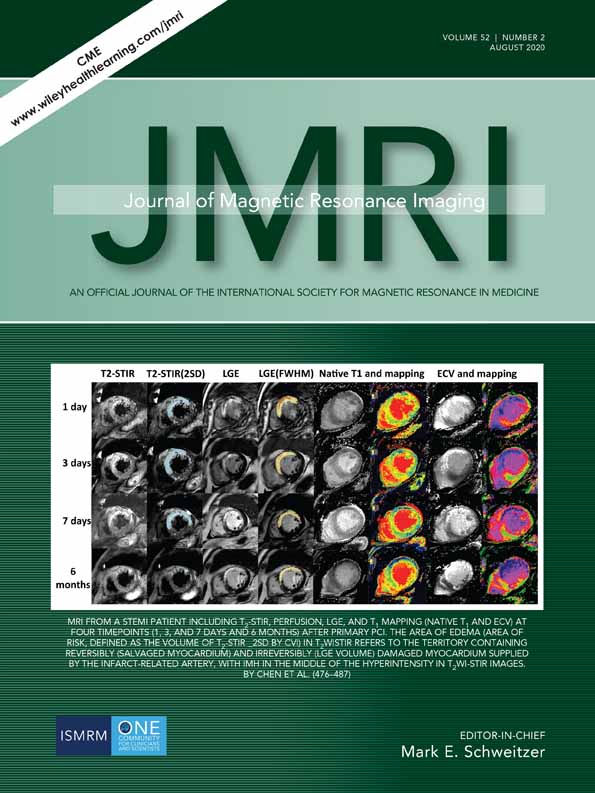Editorial
Editorial for “Children With Acute Myocarditis Often Have Persistent Subclinical Changes as Revealed by Cardiac Magnetic Resonance”
Joshua D Robinson MD,
Joshua D Robinson MD
Division of Cardiology, Ann & Robert H Lurie Children's Hospital of Chicago and Department of Pediatrics, Northwestern University Feinberg School of Medicine, Chicago, Illinois, USA
Search for more papers by this author Reza Nezafat PhD,
Corresponding Author
Reza Nezafat PhD
Department of Medicine, Cardiovascular Division, Beth Israel Deaconess Medical Center and Harvard Medical School, Boston, Massachusetts, USA
Address reprint requests to: R.N., Department of Medicine, Cardiovascular Division, Beth Israel Deaconess Medical Center and Harvard Medical School, Boston, MA, USA. E-mail:
[email protected]Search for more papers by this author
Joshua D Robinson MD,
Joshua D Robinson MD
Division of Cardiology, Ann & Robert H Lurie Children's Hospital of Chicago and Department of Pediatrics, Northwestern University Feinberg School of Medicine, Chicago, Illinois, USA
Search for more papers by this author Reza Nezafat PhD,
Corresponding Author
Reza Nezafat PhD
Department of Medicine, Cardiovascular Division, Beth Israel Deaconess Medical Center and Harvard Medical School, Boston, Massachusetts, USA
Address reprint requests to: R.N., Department of Medicine, Cardiovascular Division, Beth Israel Deaconess Medical Center and Harvard Medical School, Boston, MA, USA. E-mail:
[email protected]Search for more papers by this author
First published: 13 May 2020
No abstract is available for this article.
REFERENCES
- 1Malek LA, Kaminska H, Barczuk-Falecka M, et al. Children with acute myocarditis often have persistent subclinical changes as revealed by cardiac magnetic resonance. J Magn Reson Imaging 2020; 52: 488-496.
- 2Banka P, Robinson JD, Uppu SC, et al. Cardiovascular magnetic resonance techniques and findings in children with myocarditis: A multicenter retrospective study. J Cardiovasc Magn Reson 2015; 17(1): 96.
- 3Ferreira VM, Schulz-Menger J, Holmvang G, et al. Cardiovascular magnetic resonance in nonischemic myocardial inflammation: Expert recommendations. J Am Coll Cardiol 2018; 72(24): 3158-3176.
- 4Messroghli DR, Moon JC, Ferreira VM, et al. Clinical recommendations for cardiovascular magnetic resonance mapping of T1, T2, T2* and extracellular volume: A consensus statement by the Society for Cardiovascular Magnetic Resonance (SCMR) endorsed by the European Association for Cardiovascular Imaging (EACVI). J Cardiovasc Magn Reson 2017; 19(1): 75.
- 5Bönner F, Janzarik N, Jacoby C, et al. Myocardial T2 mapping reveals age-and sex-related differences in volunteers. J Cardiovasc Magn Reson 2015; 17(1): 9.
- 6Barczuk-Falęcka M, Małek ŁA, Werys K, Roik D, Adamus K, Brzewski M. Normal values of native T1 and T2 relaxation times on 3T cardiac MR in a healthy pediatric population aged 9–18 years. J Magn Reson Imaging 2019. [Epub ahead of print].
- 7Cornicelli MD, Rigsby CK, Rychlik K, Pahl E, Robinson JD. Diagnostic performance of cardiovascular magnetic resonance native T1 and T2 mapping in pediatric patients with acute myocarditis. J Cardiovasc Magn Reson 2019; 21(1): 40.
- 8Yang F, Wang J, Li W, et al. The prognostic value of late gadolinium enhancement in myocarditis and clinically suspected myocarditis: Systematic review and meta-analysis. Eur Radiol 2020; 30(5): 2616-2626.




